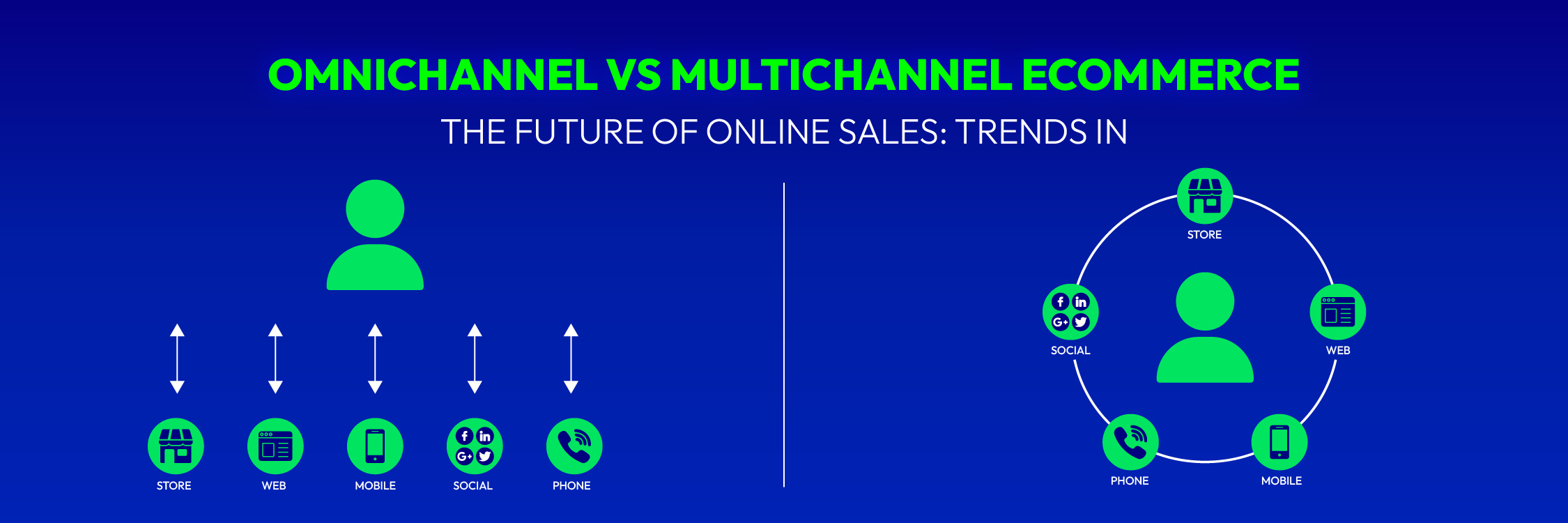Omnichannel vs Multichannel Ecommerce: Which is Better?

Consumers today have a multitude of choices when it comes to shopping, spanning mobile devices, desktops, social media platforms, physical stores, direct-to-consumer websites, and third-party retail outlets. However, the way a brand interacts with customers throughout their shopping journey can vary significantly based on whether the company employs a multichannel or omnichannel ecommerce strategy.
While these two approaches may appear similar on the surface, they possess distinct differences that can profoundly impact the overall customer experience. In this discussion, we will delve into the benefits, drawbacks, and the synergy between omnichannel vs multichannel ecommerce strategies.
What is multichannel?
 A multichannel strategy combines the customer experience and offers them the option to interact through their preferred channel. It provides flexibility but expects brands to operate within the limitations of each channel.
A multichannel strategy combines the customer experience and offers them the option to interact through their preferred channel. It provides flexibility but expects brands to operate within the limitations of each channel.
Imagine multichannel marketing as a wheel with spokes. Your product (i.e., a sale) is at the center of the wheel. Surrounding it on the outer rim are your customers, with each channel representing a distinct and separate opportunity for making a purchase. Once you identify between omnichannel vs multichannel ecommerce which channels appeal most to your target audience, you can optimize those channels to maximize your marketing endeavors.
How does multichannel retail work?
A multichannel retail strategy leverages numerous autonomous touchpoints for engaging with customers, such as websites, social media, mobile apps, and brick-and-mortar stores. Its primary objective is to broaden a company’s outreach, ensuring that its products and services are accessible across diverse platforms to cater to a wide range of customer preferences.
Multichannel retail enables businesses to target various customer segments and enhance their visibility, even when these channels are not seamlessly integrated. This approach aids companies in expanding their market presence and addressing a broader spectrum of customer requirements by providing multiple avenues for customer interaction.
Pros:
-
Increased reach and enhanced visibility
-
Adaptability in reaching diverse customer segments
-
Numerous points of contact for engaging with customers
Cons:
-
Inconsistencies in the customer experience
-
Challenges in monitoring and assessing performance
-
Restricted integration among channels
What is omnichannel?
Omnichannel represents a customer-centric sales approach aimed at delivering a unified and smooth shopping experience across various marketing channels. This strategy empowers merchants to offer their products or services through multiple platforms, such as desktops, mobile devices, and physical stores.
It revolves around tailoring communication methods to align with the reasons customers choose particular channels while also recognizing where they stand in their individual customer journey.
With omnichannel, customers have the flexibility to make purchases wherever they prefer, and instead of treating each channel as a separate entity, it considers the interaction and flow of customers between channels. This approach focuses on creating consistent and integrated customer experiences both within and across these various channels.
How does omnichannel marketing work?
Essentially, omnichannel erases the divisions that exist between various sales and marketing channels to form a cohesive and unified entity. The boundaries between channels like websites, social media, mobile apps, email, physical stores, and instant messaging vanish, giving rise to a singular perspective of the customer and a unified commerce experience.
Instead of employing a fragmented approach where each channel operates independently, omnichannel marketing blends the realms of websites, email campaigns, retargeted advertisements, social media promotion, and physical store interactions. This integration enables the presentation of personalized offers, products, and messages that cater to the unique preferences and behaviors of each customer.
Pros:
-
Enhanced customer contentment and loyalty
-
Improved data gathering and analysis
-
Rise in sales and revenue
Cons:
-
Demands substantial investments in technology and infrastructure
-
Involves intricate implementation and administration
-
Could require organizational restructuring
Key Differences between Omnichannel vs Multichannel
Several key distinctions exist between omnichannel vs multichannel strategies:
A. Integration and consistency
Omnichannel ecommerce strives for seamless integration, synchronizing data, inventory, and customer information in real-time for a unified customer journey. It prioritizes consistent brand image, product details, and service quality across all channels.
In contrast, multichannel ecommerce offers less integration, with channels often operating independently. Achieving consistency in the customer experience can be challenging due to variations in product presentation, pricing, and customer support across different touchpoints.
B. Customer journey continuity

Omnichannel strategies prioritize the continuity of the customer journey. They aim to provide a unified and consistent experience as customers transition between different channels. For example, if a customer starts browsing products on a mobile app and later continues on the website or visits a physical store, the experience should be cohesive. This ensures that customers feel they are interacting with the same brand, regardless of the channel.
In the meantime, multichannel strategies may encounter challenges in maintaining seamless customer journey continuity. Since channels in multichannel ecommerce may operate somewhat independently, transitions between them can be less smooth. Customers might experience variations in product information, pricing, or promotions as they move from one channel to another between omnichannel vs multichannel ecommerce.
C. Personalization and context-awareness
Omnichannel approaches leverage data integration and real-time synchronization across channels. This allows businesses to track customer interactions, preferences, and behaviors consistently. Consequently, they can offer highly personalized experiences, such as recommending products based on the customer’s previous online searches or in-store purchases.
However, multichannel strategies may struggle to provide the same level of data-driven personalization as omnichannel. The data collected from omnichannel vs multichannel ecommerce strategies may not always be integrated in real-time, making it harder to offer consistent and tailored recommendations or experiences across the customer’s journey.
D. Company Messaging and Brand Positioning
Multichannel marketing leverages communication channels for company-to-public messaging, adjusting strategies based on audience response to optimize outcomes, such as expanding reach, enhancing customer engagement, and increasing sales.
In contrast, omnichannel marketing involves customer-centric communication. It begins with gathering customer information and tailoring messages accordingly to improve ad performance by delivering products and services aligned with customer needs.
Therefore, in multichannel marketing, the focus is on the company’s interests in communication strategy, while in omnichannel marketing, the emphasis is on the customer’s needs and experience.
Impact on Customer Loyalty and Retention

A. How omnichannel experience fosters stronger customer loyalty
In the fiercely competitive landscape of e-commerce, branding plays a pivotal role in setting companies apart. Effective branding allows businesses to communicate their unique story to consumers, providing a distinct advantage in a crowded market. Building well-branded relationships with customers is a formidable challenge in the world of e-commerce, where fostering customer loyalty is a complex endeavor.
- Proper Customer Segmentation
To thrive in today’s e-commerce realm, companies must adopt omnichannel communication strategies. This entails customer segmentation, personalized communication, and timely engagement. By segmenting their customer base, businesses can create highly relevant campaigns that cultivate loyalty and enhance customer lifetime value.
Traditionally, segmentation encompassed geographic, demographic, psychographic, and behavioral factors. However, the advent of AI-powered engagement automation has expanded segmentation possibilities exponentially.
- Personalized Communication
Personalized communication is another cornerstone of effective customer relationship management. Consumers crave one-on-one interactions and 63% of them are even willing to share private data for a personalized shopping experience.
Beyond basic personalization like using a customer’s first name, modern strategies delve into more intricate tactics. This includes tailoring upsell offerings based on individual interests, displaying personalized abandoned cart items, and presenting time-sensitive deals when visitors are about to leave the site.
- Engagement
Timely engagement is paramount in meeting customers where they are in the buying process. Website banners offer a dynamic tool for delivering the right message to the right person at the right moment. These banners can serve various purposes, from announcing critical information like Free Shipping to enticing customers to subscribe or providing surveys to gain insights.
Research indicates that employing three or more interconnected channels in an automated fashion resulted in an 18.96% engagement rate, whereas using just a single channel yielded a mere 5.4% engagement rate. Additionally, customers who interacted with three or more channels made purchases 250% more frequently compared to those who only engaged with a single channel.
B. Role of multichannel experience in customer retention
Implementing a multichannel approach in your customer engagement platform can significantly boost retention efforts. This involves communicating with customers through their preferred platforms like personalized emails, social media, mobile apps, and targeted ads, ultimately enhancing brand visibility and accessibility. Such a strategy not only streamlines the service process but also improves cost-effectiveness.
- Well-structured service process, leading to enhanced cost efficiency
To create the best multichannel customer experience, it’s crucial to design your service process with a strong customer-centric focus. This necessitates a customer-oriented operating strategy, supported by high-performance technology, such as Dynamics 365 for Customer Engagement.
Rather than simply adding new systems to old processes, it’s essential to map the customer’s current journey for information acquisition, purchases, and service as it stands today. Customer behavior has evolved significantly, and the wealth of available customer data demands a modernized approach aligned with today’s tools and requirements.
The modern way of working is generally more cost-effective, thanks to the precision of analytics tools that enable accurate targeting and a deeper understanding of customer needs. Process acceleration and automation not only remove manual steps but also generate new value-added services.
A critical prerequisite for success is designing your system with teamwork capabilities from the outset. Complex cases for B2B customers often require collaborative efforts, making it crucial for systems to transcend silos and functions in an omnichannel setup.
- Multichannel functionality in customer procurement
Multichannel functionality proves valuable even in the early stages of customer acquisition when the potential customer’s name may not be known. It ensures immediate access to information through any channel provided, guiding prospects seamlessly along the account path. Inconsistencies, such as varying responses between phone service and websites, highlight gaps in your omnichannel strategies.
A multichannel presence supports customer acquisition, enabling communication where customers are most comfortable. Simple services, like shopping cart reminders, can lead to a 10-15% completion rate among those who initially abandoned their purchases.
- Multichannel customer experience improves customer retention Furthermore, a multichannel customer experience significantly improves customer retention, resulting in increased trade, deeper customer insights, and lower marketing and sales costs. Effective service routing and prompt resolution of issues build trust, reinforcing the idea that doing business through any channel is easy and efficient, supported by a system that understands customer history and satisfaction survey results, facilitating targeted marketing and communication.
C. Real-world examples of successful strategies
There are various methods to implement an omnichannel vs multichannel ecommerce retail strategy. Both rely on well-structured product data, but an omnichannel approach involves more personalized marketing efforts and demands more intricate data synchronization than a segmented multichannel setup.
Omnichannel

Apple serves as a prime example of successful omnichannel retailing. While it primarily operates through its physical stores and online website, it also engages in wholesale partnerships with major retailers like Target, Best Buy, and Costco. Despite these varied sales channels, Apple maintains a consistent brand identity that extends to its services and applications.
Notably, Apple products purchased from any location worldwide can be serviced at its Genius Bar repair centers, showcasing a unified customer support experience. The company’s strategic focus is evident, with its brick-and-mortar stores designed to bolster its e-commerce channel. These physical locations primarily serve to enhance brand awareness and overall customer experience. For instance, if a product is unavailable in a store, customers are encouraged to visit Apple’s online store for their purchase, ensuring a seamless transition between channels.
Having access to your customer’s birthdate enables you to send them a birthday email containing a special discount or coupon code, redeemable both online and in physical stores. Sephora excels in this aspect by providing customers with a selection of birthday coupons, most of which are valid for use during the customer’s birth month.
Disney serves as the benchmark for omnichannel retailing. Their comprehensive omnichannel experience commences with their website and extends to the My Disney Experience tool, allowing visitors to meticulously plan every aspect of their trip. This includes using the app to access ride schedules, attractions, and real-time wait times once inside the park. Disney enhances the experience further by offering MagicBands wristbands that enable users to unlock hotel rooms, access guest photos, place food orders, and more.
Read more: Disney Marketing Strategy - How They Became Entertainment King
Multichannel

Murad, a skincare company, operates solely through its online store and does not have physical storefronts. Their products are distributed through various retailers like Sephora, Ulta, as well as salon and spa businesses such as Massage Envy. Consequently, any product-related concerns or issues must be addressed directly with the retailer where the purchase was made. Murad’s loyalty program is exclusively applicable to purchases made directly on their website.
While Murad offers virtual consultations and quizzes on its website for personalized product recommendations, these features do not extend to experiences at authorized third-party spas that utilize Murad products. In such cases, the online consultation and recommendation services do not carry over to in-person skincare services.
Gymshark, a rapidly expanding global fitness and apparel brand, transitioned to Shopify Plus following an eight-hour outage caused by a Black Friday crash.
Their multichannel growth strategy yielded impressive results, including a 9.3 times ROI on a Black Friday social media campaign and a substantial 197% increase in overall holiday revenue. This surge in performance led to a remarkable $128 million in revenue for the financial year 2018.
Gymshark relies on Shopify Plus to deliver personalized customer experiences, execute site-wide promotions, and manage global campaigns, all while benefiting from a reliable and customizable platform. Their innovative marketing campaigns have garnered recognition from Facebook executives, contributing significantly to Gymshark’s impressive success story.
Kūla
Kūla, a sustainable fashion brand, operates through a combination of digital and in-person sales channels. Customers have the option to buy products directly from Kūla’s Shopify website or at various markets and pop-up events. In cases where customers make purchases through these channels, the brand can include them in its customer database and subsequently engage with email promotions or retargeting advertisements.
Kūla’s clothing line is additionally stocked at specific physical retail stores. However, when a customer chooses to make a purchase at one of these brick-and-mortar locations, they still enjoy the same exquisite designs, but the brand is unable to gather any customer data from these transactions.
How to choose between omnichannel vs. multichannel strategies?
Your choice should be driven by your overarching business objectives. If your aim is to enhance specific brand goals, adopting multichannel strategies may be beneficial. On the other hand, if your goal is to enhance the overall customer experience, embracing an omnichannel approach can help you enhance the broader perspective.
Furthermore, your decision should take into account your available resources. Smaller brands may find it challenging to launch fully comprehensive omnichannel strategies immediately, so starting with incremental steps within a multichannel framework is a practical way to build momentum gradually. For instance, there’s no need to simultaneously roll out a website, email newsletter, social media presence, and marketing campaigns. Initially, focusing on individual channels and gradually integrating updates can be advantageous.
Conclusion
Prioritizing customer experience is paramount for any business or organization. In this regard, an omnichannel approach surpasses a basic multichannel approach. This doesn’t imply avoiding the expansion of communication channels with customers. On the contrary, a business should always be present where its customers prefer to engage, as offering these preferred channels sets it apart from competitors.
An omnichannel approach essentially encompasses a multichannel approach, as it provides customers with multiple contact and marketing channels. The key distinction between omnichannel vs multichannel e-commerce lies in the holistic treatment of all these channels as integral parts of a unified whole rather than treating each channel in isolation. This approach ensures a seamless and consistent customer experience across all touchpoints, reinforcing its value in modern business practices.






![Top 20+ Must-have Shopify Apps for 2025 [Free & Paid] - Mageplaza](https://cdn2.mageplaza.com/media/blog/must-have-shopify-apps/top-must-have-shopify-apps.png)
![[2025 Updates] Top 10+ Upsell Apps for Shopify - Mageplaza](https://cdn2.mageplaza.com/media/blog/best-upsell-shopify-app/cover.png)